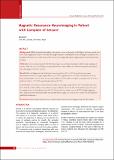Please use this identifier to cite or link to this item:
https://hdl.handle.net/20.500.14356/1970Full metadata record
| DC Field | Value | Language |
|---|---|---|
| dc.contributor.author | Koirala, K | - |
| dc.date.accessioned | 2023-06-04T07:27:25Z | - |
| dc.date.available | 2023-06-04T07:27:25Z | - |
| dc.date.issued | 2011 | - |
| dc.identifier.citation | KoiralaK. (2011). Magnetic Resonance Neuroimaging in Patient with Complain of Seizure. Journal of Nepal Health Research Council. https://doi.org/10.33314/jnhrc.v0i0.256 | en_US |
| dc.identifier.issn | Print ISSN: 1727-5482; Online ISSN: 1999-6217 | - |
| dc.identifier.uri | http://103.69.126.140:8080/handle/20.500.14356/1970 | - |
| dc.description | Original Article | en_US |
| dc.description.abstract | Abstract Background: MRI is the preferred modality to investigate seizure as diagnostic yield is higher and more specific due to its varied applications. Total of 160 brain MR images of patients suffering from seizure during one year period was evaluated. All seizure cases underwent specific protocol for imaging that targeted hippocampal/mesial temporal lobe imaging. Methods: A cross sectional study of 160 MRI brain images was performed in patients with the main complaint of seizure within one-year period. The percentage distribution of abnormalities was calculated separately for pediatric and adult groups with Excel software. Results: The total diagnostic yield of abnormal cases ranged from 53% to 55%. In pediatric group major abnormalities found were hippocampal sclerosis 4 (21%) ‘T2 hyperintense foci in various distributions’ 4 (21%), and cortical atrophy 4 (21%) where as major abnormalities found in adults were space occupying lesions 19 (27%),ischemia/ infarcts 11 (16.2%), granulomatous lesions 8 (11%). Conclusions: Lesions that are better detected in MRI include hippocampal sclerosis and T2 hyperintensities that form the bulk of abnormalities in the pediatric category. Majority of abnormalities in the adult category like space occupying lesions can be easily picked up by CT whereas refractory seizure, cases with EEG findings suggesting TLE, suspected stroke should preferably undergo MRI brain imaging as it is much more sensitive in detecting these pathological substrates.v Keywords: epilepsy, hippocampal sclerosis, mesial temporal sclerosis, neuroimaging, temporal lobe epilepsy | en_US |
| dc.language.iso | en | en_US |
| dc.publisher | Nepal Health Research Council | en_US |
| dc.relation.ispartofseries | April;256 | - |
| dc.subject | Epilepsy | en_US |
| dc.subject | Hippocampal sclerosis | en_US |
| dc.subject | Mesial temporal sclerosis | en_US |
| dc.subject | Neuroimaging | en_US |
| dc.subject | Temporal lobe epilepsy | en_US |
| dc.title | Magnetic Resonance Neuroimaging in Patient with Complain of Seizure | en_US |
| dc.type | Journal Article | en_US |
| local.journal.category | Original Article | - |
| Appears in Collections: | Vol 9 No 1 Issue 18 April 2011 | |
Files in This Item:
| File | Description | Size | Format | |
|---|---|---|---|---|
| 256-Article Text-254-1-10-20130822.pdf | Fulltext Download | 133.82 kB | Adobe PDF |  View/Open |
Items in DSpace are protected by copyright, with all rights reserved, unless otherwise indicated.
